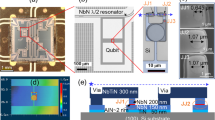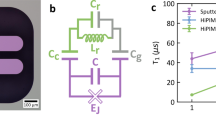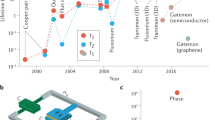Abstract
Dielectrics with low loss at microwave frequencies are imperative for high-coherence solid-state quantum computing platforms. Here we study the dielectric loss of hexagonal boron nitride (hBN) thin films in the microwave regime by measuring the quality factor of parallel-plate capacitors (PPCs) made of NbSe2–hBN–NbSe2 heterostructures integrated into superconducting circuits. The extracted microwave loss tangent of hBN is bounded to be at most in the mid-10−6 range in the low-temperature, single-photon regime. We integrate hBN PPCs with aluminium Josephson junctions to realize transmon qubits with coherence times reaching 25 μs, consistent with the hBN loss tangent inferred from resonator measurements. The hBN PPC reduces the qubit feature size by approximately two orders of magnitude compared with conventional all-aluminium coplanar transmons. Our results establish hBN as a promising dielectric for building high-coherence quantum circuits with substantially reduced footprint and with a high energy participation that helps to reduce unwanted qubit cross-talk.
This is a preview of subscription content, access via your institution
Access options
Access Nature and 54 other Nature Portfolio journals
Get Nature+, our best-value online-access subscription
$29.99 / 30 days
cancel any time
Subscribe to this journal
Receive 12 print issues and online access
$259.00 per year
only $21.58 per issue
Buy this article
- Purchase on Springer Link
- Instant access to full article PDF
Prices may be subject to local taxes which are calculated during checkout




Similar content being viewed by others
Data availability
The data that supports the findings of this study are available from the corresponding author upon reasonable request and with the cognizance of our US Government sponsors who funded the work.
References
Kjaergaard, M. et al. Superconducting qubits: current state of play. Annu. Rev. Condens. Matter Phys. 11, 369–395 (2020).
Martinis, J.M. et al. Decoherence in Josephson qubits from dielectric loss. Phys. Rev. Lett. 95, 210503 (2005).
Gambetta, J. M. et al. Investigating surface loss effects in superconducting transmon qubits. IEEE Trans. Appl. Supercond. 27, 1700205 (2016).
Müller, C., Cole, J. H. & Lisenfeld, J. Towards understanding two-level-systems in amorphous solids: insights from quantum circuits. Rep. Prog. Phys. 82, 124501 (2019).
Woods, W. et al. Determining interface dielectric losses in superconducting coplanar-waveguide resonators. Phys. Rev. Appl. 12, 014012 (2019).
Arute, F. et al. Quantum supremacy using a programmable superconducting processor. Nature 574, 505–510 (2019).
Zajac, D. et al. Spectator errors in tunable coupling architectures. Preprint at https://arxiv.org/abs/2108.11221 (2021).
Dean, C. R. et al. Boron nitride substrates for high-quality graphene electronics. Nat. Nanotechnol. 5, 722–726 (2010).
Geim, A. K. & Grigorieva, I. V. Van der waals heterostructures. Nature 499, 419–425 (2013).
Caldwell, J. D. et al. Photonics with hexagonal boron nitride. Nat. Rev. Mater. 4, 552–567 (2019).
Wang, J. I.-J. et al. Coherent control of a hybrid superconducting circuit made with graphene-based van der Waals heterostructures. Nat. Nanotechnol. 14, 120–125 (2019).
Schmidt, F.E., Jenkins, M.D., Watanabe, K., Taniguchi, T. & Steele, G.A. A ballistic graphene superconducting microwave circuit. Nat. Commun. 9, 4069 (2018).
Kroll, J.G. et al. Magnetic field compatible circuit quantum electrodynamics with graphene Josephson junctions. Nat. Commun. 9, 4615 (2018).
Laturia, A., Van de Put, M. L. & Vandenberghe, W. G. Dielectric properties of hexagonal boron nitride and transition metal dichalcogenides: from monolayer to bulk. NPJ 2D Mater. Appl. 2, 6 (2018).
Wang, L. et al. One-dimensional electrical contact to a two-dimensional material. Science 342, 614–617 (2013).
Probst, S., Song, F. B., Bushev, P. A., Ustinov, A. V. & Weides, M. Efficient and robust analysis of complex scattering data under noise in microwave resonators. Rev. Sci. Instrum. 86, 024706 (2015).
Xi, X. et al. Ising pairing in superconducting NbSe2 atomic layers. Nat. Phys. 12, 139–143 (2016).
Ugeda, M. M. et al. Characterization of collective ground states in single-layer NbSe2. Nat. Phys. 12, 92–97 (2016).
De Visser, P. et al. Evidence of a nonequilibrium distribution of quasiparticles in the microwave response of a superconducting aluminum resonator. Phys. Rev. Lett. 112, 047004 (2014).
Barends, R. et al. Coherent Josephson qubit suitable for scalable quantum integrated circuits. Phys. Rev. Lett. 111, 080502 (2013).
Yan, F. et al. The flux qubit revisited to enhance coherence and reproducibility. Nature Commun. 7, 12964 (2016).
Schoelkopf, R., Clerk, A., Girvin, S., Lehnert, K. & Devoret, M. in Quantum Noise in Mesoscopic Physics (ed. Nazarov, Y. V.) 175–203 (Springer, 2003).
Haigh, S. et al. Cross-sectional imaging of individual layers and buried interfaces of graphene-based heterostructures and superlattices. Nat. Mater. 11, 764–767 (2012).
Wisbey, D. S. et al. Dielectric loss of boron-based dielectrics on niobium resonators. J. Low Temp. Phys. 195, 474–486 (2019).
Weber, S. J., Murch, K. W., Slichter, D. H., Vijay, R. & Siddiqi, I. Single crystal silicon capacitors with low microwave loss in the single photon regime. Appl. Phys. Lett. 98, 172510 (2011).
Cho, K.-H. et al. Epitaxial Al2O3 capacitors for low microwave loss superconducting quantum circuits. APL Mater. 1, 042115 (2013).
Kim, S. et al. Enhanced coherence of all-nitride superconducting qubits epitaxially grown on silicon substrate. Commun. Mater. 2, 98 (2021).
Zhao, R. et al. Merged-element transmon. Phys. Rev. Appl. 14, 064006 (2020).
Mamin, H. J. et al. Merged-element transmons: design and qubit performance. Phys. Rev. Appl. 16, 024023 (2021).
Lee, J. S. et al. Wafer-scale single-crystal hexagonal boron nitride film via self-collimated grain formation. Science 362, 817–821 (2018).
Chen, T.-A. et al. Wafer-scale single-crystal hexagonal boron nitride monolayers on Cu(111). Nature 579, 219–223 (2020).
Antony, A. et al. Miniaturizing transmon qubits using van der Waals materials. Nano Lett. 21, 10122–10126 (2021).
Acknowledgements
We acknowledge helpful discussions with G. Calusine, T. Hazard, D. Klein, D. MacNeill, K. O’Brien, A. Di Paolo and A. Vepsäläinen. We thank R. Das at MIT Lincoln Laboratory for technical assistance. This research was funded in part by the US Army Research Office grant number W911NF-18-S-0116, by the National Science Foundation QII-TAQS grant number OMA-1936263, and by the Assistant Secretary of Defense for Research & Engineering via MIT Lincoln Laboratory under Air Force contract number FA8721-05-C-0002. K.W. and T.T. acknowledge support from the Elemental Strategy Initiative conducted by the MEXT, Japan (grant number JPMXP0112101001) and JSPS KAKENHI (grant numbers 19H05790 and JP20H00354). The views and conclusions contained herein are those of the authors and should not be interpreted as necessarily representing the official policies or endorsements of the US Government.
Author information
Authors and Affiliations
Contributions
J.I-J.W. and M.A.Y. conceived and designed the experiment. M.A.Y. performed the microwave simulation. J.I-J.W., M.A.Y., Q.L., T.D., D.K., A.J.M., B.M.N, K.S., J.L.Y. and M.E.S. contributed to the device fabrication. J.I-J.W., M.A.Y., A.H.K., S.E.M., B.K., Y.S., J.B., S.G. and R.W. participated in the measurements. M.A.Y., J.I-J.W. and A.H.K analysed the data. K.W. and T.T. grew the hBN crystal. J.I-J.W. and W.D.O. led the paper writing, and all other authors contributed to the text. T.P.O., S.G., P.J-H. and W.D.O supervised the project.
Corresponding authors
Ethics declarations
Competing interests
The authors declare no competing interests.
Peer review
Peer review information
Nature Materials thanks Mark Hersam and the other, anonymous, reviewer(s) for their contribution to the peer review of this work.
Additional information
Publisher’s note Springer Nature remains neutral with regard to jurisdictional claims in published maps and institutional affiliations.
Supplementary information
Supplementary information
Supplementary Figs. 1–4 and Table 1.
Rights and permissions
About this article
Cite this article
Wang, J.IJ., Yamoah, M.A., Li, Q. et al. Hexagonal boron nitride as a low-loss dielectric for superconducting quantum circuits and qubits. Nat. Mater. 21, 398–403 (2022). https://doi.org/10.1038/s41563-021-01187-w
Received:
Accepted:
Published:
Issue Date:
DOI: https://doi.org/10.1038/s41563-021-01187-w
This article is cited by
-
The Roadmap of 2D Materials and Devices Toward Chips
Nano-Micro Letters (2024)
-
Noisy intermediate-scale quantum computers
Frontiers of Physics (2023)
-
2D materials shrink superconducting qubits
Nature Materials (2022)
-
Engineering superconducting qubits to reduce quasiparticles and charge noise
Nature Communications (2022)
-
A gate-tunable graphene Josephson parametric amplifier
Nature Nanotechnology (2022)



